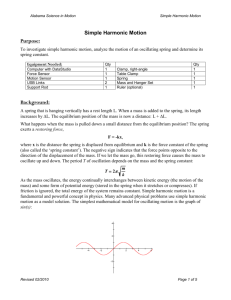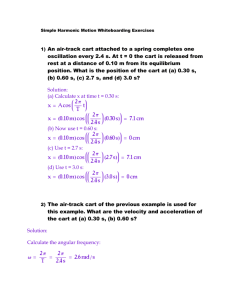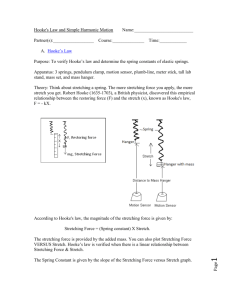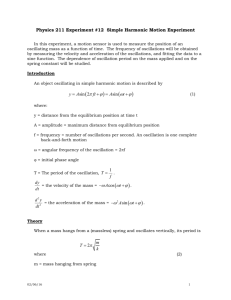SHM Revised Teacher Notes
advertisement
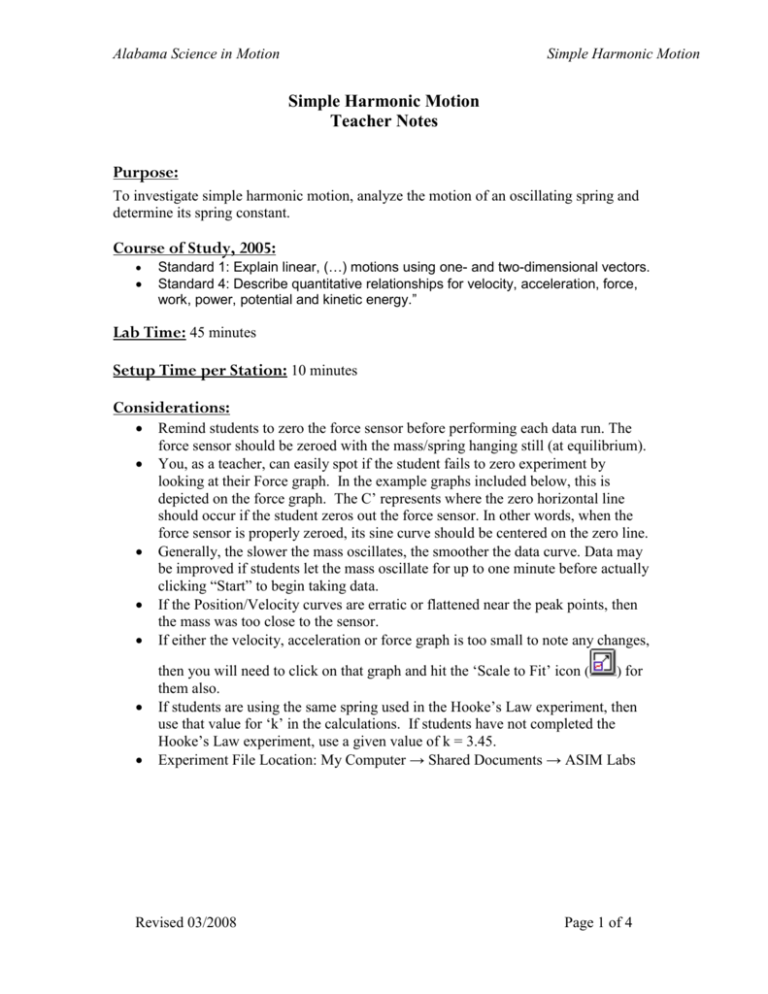
Alabama Science in Motion Simple Harmonic Motion Simple Harmonic Motion Teacher Notes Purpose: To investigate simple harmonic motion, analyze the motion of an oscillating spring and determine its spring constant. Course of Study, 2005: Standard 1: Explain linear, (…) motions using one- and two-dimensional vectors. Standard 4: Describe quantitative relationships for velocity, acceleration, force, work, power, potential and kinetic energy.” Lab Time: 45 minutes Setup Time per Station: 10 minutes Considerations: Remind students to zero the force sensor before performing each data run. The force sensor should be zeroed with the mass/spring hanging still (at equilibrium). You, as a teacher, can easily spot if the student fails to zero experiment by looking at their Force graph. In the example graphs included below, this is depicted on the force graph. The C’ represents where the zero horizontal line should occur if the student zeros out the force sensor. In other words, when the force sensor is properly zeroed, its sine curve should be centered on the zero line. Generally, the slower the mass oscillates, the smoother the data curve. Data may be improved if students let the mass oscillate for up to one minute before actually clicking “Start” to begin taking data. If the Position/Velocity curves are erratic or flattened near the peak points, then the mass was too close to the sensor. If either the velocity, acceleration or force graph is too small to note any changes, then you will need to click on that graph and hit the ‘Scale to Fit’ icon ( ) for them also. If students are using the same spring used in the Hooke’s Law experiment, then use that value for ‘k’ in the calculations. If students have not completed the Hooke’s Law experiment, use a given value of k = 3.45. Experiment File Location: My Computer → Shared Documents → ASIM Labs Revised 03/2008 Page 1 of 4 Alabama Science in Motion Simple Harmonic Motion Sample graphs: Revised 03/2008 Page 2 of 4 Alabama Science in Motion Simple Harmonic Motion Position Velocity Acceleration Force Time Data Table Peak 1 Time (s) 0.3466 Period (s) Mass = __0_.025 2 3 4 5 6 7 0.9146 1.4821 2.0487 2.6176 3.1935 3.7531 0.568 0.5675 0.5666 0.5689 0.5759 0.5596 kg Average period of oscillation = _0.57075 Revised 03/2008 sec Page 3 of 4 Alabama Science in Motion Simple Harmonic Motion Answers to Questions: 1. Calculate the theoretical value for the period of oscillation based on the measured value of the spring constant of the spring and the mass on the end of the spring. T 2 m k T = 2(3.14)√(.025/3.45) T = 0.5646 s 2. How does your calculated value for oscillation compare to the measured value of the period of oscillation? What is the percent difference? Period calculated is less. Percent difference = │0.53458 – 0.57075│ X 100 0.53458 Percent difference = 6.8% 3. Use the space below to respond the directions and questions found in step 3 of the section Analyzing the Data. A. At Point A, the maximum force reading occurs when the acceleration is at a maximum. This also occurs when the position of the spring is at a low point, closest to the motion sensor. Velocity at Point A is zero—no change in position at that time. B. At Point B, the largest negative force occurs when the acceleration is at a maximum value but in the opposite direction. This occurs when the position of the spring is at a high point, located at the maximum distance away from the motion sensor. Velocity at Point B is zero. C. At Point C, the spring is at its equilibrium position. Position, acceleration and force readings will be zero. At this position, the velocity of the spring is at its maximum. D. At Point D, readings for the acceleration, position and force should again be at the zero mark. These occur at an equivalent spot on the sine wave generated. Revised 03/2008 Page 4 of 4

